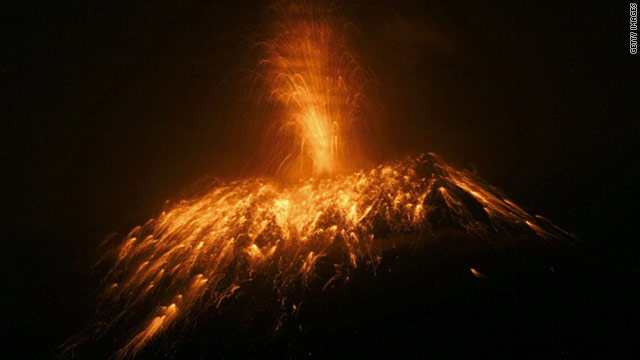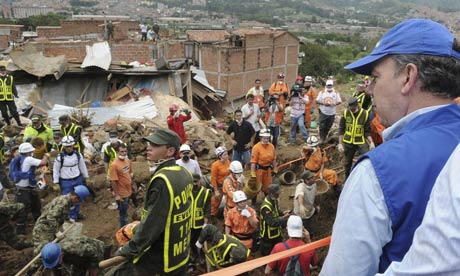
McCarthy's Blog
-Current Environmental Hazards Across The Globe-
Friday, December 10, 2010
"Throat of Fire" Produces Fire - Volcano in Ecuador Erupts
Ecuador - As the country's National Agency of Risk Control issued a 'red alert' a few days ago, residents evacuated the area immediately. Proving that an early warning and mandatory evacuations are effective; seeing as no casualties have been reported. The volcano named Tungurahua means 'Throat of Fire' and last week it opened its throat right up and projected that fire straight up into the sky. In fact, ash and lava shot a mile into the sky!! An ash cloud eventually formed 2 miles above the volcano's caldera. Tungurahua reaches an elevation of 16,478 feet and has erupted periodically since 1999.


Colombian Landslide
Colombia's rainfall this year is the highest on record since the country's weather service was created 42 years ago. The large amounts of rain have been partially caused by the La Nina weather phenomenon; also creating havoc for Venezuela and surrounding countries. In Colombia alone, an estimated 1.6 million people's houses have been damaged or completely lost due to massive amounts of flooding. This number is so high because of terrible development planning; about 70% of the population lives in inundated flood plains. Recently, a landslide buried a less developed suburb where 100 people are still missing and 23 deaths have been reported; 11 of which are children. An estimated 1.7 million cubic feet of earth buried thirty brick houses. The death toll from mudslides and floods for Colombia this year is now up to 199. Last year they were at 110 and the previous year there were a total of 48 people killed.


Wednesday, December 1, 2010
Earthquake in Fiji
A strong 6.1 magnitude earthquake struck in the waters near Fiji this morning. No immediate injuries or damages were reported. The quake struck at a depth of 9.4 miles and 115 miles east-northeast of Lambasa. Fortunately, no tsunami warning was in effect after the quake hit.


Tuesday, November 30, 2010
Venezuela Gets Dumped On
Heavy rains have been hitting Venezuela hard over the last few days creating large floods and landslides. Hugo Chavez has declared a state of emergency for the western part of the country as the military continues to aid victims. As for the numbers; about 5,000 people have been displaced with 17 deaths reported in the last day - bringing the total death toll up to 30. Officials say that the heavy rains in November have continued past the regular wet season causing 'ill-effects' on over 50,000 people nationwide. Many of the deaths have been from people being washed away from rivers and mudslides. These hazards have blocked a very important coastal highway in the city of Vargas. The flooding has also caused power outages that have closed down two oil refineries for the time being; meaning an extreme loss of profits for the next few days.
In December of 1999, thousands were killed in the same area (Vargas) as water and mudslides came down from the mountains close by. This tells me that some sort of precaution needs to be set forth to protect from floods/mudslides that are likely to happen in the future. These precautions may include some sort of levee system, damn, or a canal that would diverge floods away from the city. Other communities (like the one pictured below) may benefit from a wall at the base of the hillside to try to restrict mudslides from passing.


In December of 1999, thousands were killed in the same area (Vargas) as water and mudslides came down from the mountains close by. This tells me that some sort of precaution needs to be set forth to protect from floods/mudslides that are likely to happen in the future. These precautions may include some sort of levee system, damn, or a canal that would diverge floods away from the city. Other communities (like the one pictured below) may benefit from a wall at the base of the hillside to try to restrict mudslides from passing.


Monday, November 22, 2010
Death Toll Rises as Landslides Continue in Vietnam
The death toll of the recent floodings in Vietnam is now up to a staggering 178 people. Abundant amounts of rain began dumping on Central Vietnam in early October. This is the 'third stage' of the viscous floodings within the last six weeks and it killed 11 Vietnamese yesterday. An astonishing 30 inches of rain hit the country just within the last 72 hours. Unfortunately, the recent 11 deaths include many children under the age of 10 years old. Authorities have distributed at least 1,000 tons of rice so far to the flood victims, but the locals say they will at least need 5,000 more tons! Vietnam is prone to floods and storms which kill hundreds of people each year.
If Vietnam is so prone to these storms, the government should do a better job at notifying locals of future weather patterns and storms coming into the area. If a large amount of rainfall is expected to fall, officials should go around to villages to tell the locals they may need to prepare for an evacuation. This would help the death toll tremendously as well as saving the locals possessions and food.

If Vietnam is so prone to these storms, the government should do a better job at notifying locals of future weather patterns and storms coming into the area. If a large amount of rainfall is expected to fall, officials should go around to villages to tell the locals they may need to prepare for an evacuation. This would help the death toll tremendously as well as saving the locals possessions and food.

Monday, November 8, 2010
FEAR OF CHOLERA OUTBREAK IN HAITI
Hurricane Tomas, which swept over Haiti this past weekend, isn't done with its destructive ways just yet; a cholera outbreak that began last month is expected to worsen in the days to come. The outbreak has already killed hundreds of victims and left thousands hospitalized within the last month. An astonishing 8,000 cases have already been confirmed. The biggest concern for disaster is the water flooding/flowing through towns causing latrines and septic tanks to overflow. This would in turn contaminate the fresh drinking water all while spreading the bacteria around at a devastating rate.
This is a great example of how devastating a secondary disaster/hazard caused by a primary disaster (in this case a hurricane) can be. The hurricane itself only killed 20 people and injured 36, but this secondary disaster (flooding/cholera outbreak) has killed 544 people as of today; proving to be much more of a disaster then the hurricane itself. Locals should evacuate the affected area, if at all possible, and only drink clean water from the surrounding non-affected areas. It would be smart to stay out of the flooded towns until the cholera-contaminated water recedes.

This is a great example of how devastating a secondary disaster/hazard caused by a primary disaster (in this case a hurricane) can be. The hurricane itself only killed 20 people and injured 36, but this secondary disaster (flooding/cholera outbreak) has killed 544 people as of today; proving to be much more of a disaster then the hurricane itself. Locals should evacuate the affected area, if at all possible, and only drink clean water from the surrounding non-affected areas. It would be smart to stay out of the flooded towns until the cholera-contaminated water recedes.

Thursday, November 4, 2010
VOLCANO KILLS
MOUNT MERAPI, INDONESIA --
An eruption this morning from Mount Merapi was the deadliest and most explosive yet of a string of eruptions that have occured for the past week. It sent more villagers fleeing for safety and left three locals dead this morning - setting the death toll at 44 people within 8 days. Most of these deaths came from the initial explosion/first day (October 26th) and the chaotic evacuations that followed. But it appears that there is more to come - state volcanologists predict that the worst is still yet to come. Mount Merapi is one of the world's most active volcanoes; killing 60 people in 1994 and destroying more than a dozen villages in 1930 - leaving up to 1,300 dead! Locals are crowded in government camps where 70,000 people may be staying for weeks or maybe even months. Ash fallout burst into the air as high as 20,000 feel - preventing planes to fly over the area. Indonesia is prone to earthquakes and volcanoes due to its location along the Pacific Ring of Fire.
To prevent further injuries and deaths, locals should stay clear of the hazardous areas and work corporately with the people giving aid/government camps. Volcanologists and Seismologists need to keep a close eye on Mount Merapi's actions and give fair advance warnings if danger is near.

Subscribe to:
Posts (Atom)